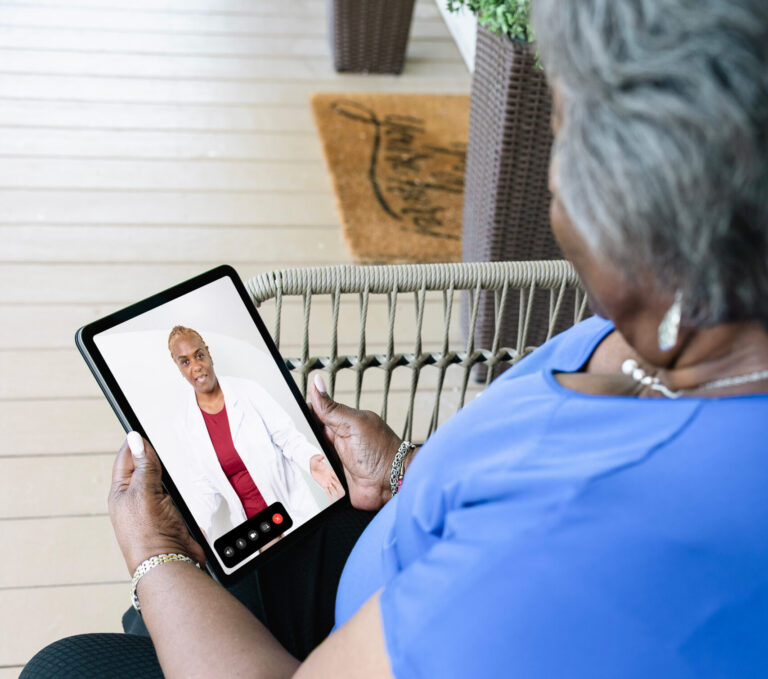This content has been reviewed for accuracy by Amanda Minimi, Director of Corporate Development for Aeroflow Health.
Health equity is a hot topic among many in the healthcare world. The term refers to the idea that everyone should have a fair and equal opportunity to achieve good health regardless of race, income or social status. In addition, health equity addresses the social, economic and environmental factors that impact a person’s well-being. As we look at solving health equity issues, it is imperative that we take a true population health approach recognizing that one size does not fit all and leverage new age tools, technology and resources to combat equity issues. This is where telehealth comes into play.
Telehealth Health Equity – Why It Matters
Telehealth leverages digital tools and technology to provide healthcare services remotely, enabling individuals to receive medical advice, diagnoses, and treatment without physical visits to healthcare facilities. Telehealth helps reach those in the underserved communities that would otherwise lack equal access to care.
Underserved communities often include:
- Low income Americans
- Rural Americans
- People of color
- Immigrants
- People who identify as LGBTQ
- People with disabilities
- Older patients
- People with limited knowledge of the English language
- People with limited digital literacy
- People who are underinsured or uninsured
Those who fall into any of the above categories often face consequences such as higher mortality rates, higher medical costs, higher rates of disease and more. Key drivers of these disproportionate consequences include lack of access to transportation, lack of access to appropriately skilled providers, or time to care.
For example, the journey of pregnancy into postpartum care can be both exciting and overwhelming for mothers. Telehealth can serve as a support system that offers convenience and reassurance all from the comfort of home. Virtual consultations from experts on prenatal care, lactation support and mental health, addresses any concerns or complications promptly while also addressing commonly cited challenges in breastfeeding such as lack of time due to childcare responsibilities, lack of finances, or doctor did not explain/ provide support. Telehealth opens a convenient avenue for integrated and comprehensive care that may otherwise be inaccessible. Lactation consults are regularly non-covered by lactation providers and require members to pay upwards of $300 per visit and seek reimbursement directly from the plan following the visit. Where telehealth is not available, breastfeeding becomes a luxury. However, there is both high levels of interest and engagement in utilizing services like lactation consultations via telehealth. Recent data from Aeroflow Breastpumps shows that 87% of their patients who qualify for lactation services and opt-in to telehealth were between the ages of 25 and 40, proving that mothers who are given the option of telehealth visits are very likely to take advantage of the resource.
Access to telehealth provides limitless solutions to a variety of patient needs from PAP therapy set-ups to nutrition counseling for managing diabetes, the possibilities are endless. Telehealth stands as a transformative force not just for patients but also for healthcare providers. Beyond offering convenience and accessibility to patients, telehealth becomes a strategic solution to address staffing shortages and combat physician burnout. By facilitating remote services, clinicians can efficiently monitor patients’ progress, ensuring timely interventions and keeping treatment plans dynamically updated. In this symbiotic relationship, telehealth emerges as a powerful tool for optimizing healthcare delivery and enhancing the overall well-being of both patients and providers.
Barriers to Telehealth
Though telehealth proves to be an ideal alternative for healthcare for many people, there are still a variety of barriers that keep this solution from meeting all people where they are.
Some of those barriers include:
- Lack of coverage of telehealth benefits
- Lack of coverage or provider types
- Lack of listing in provider directory
According to the American Medical Association, 80% of health happens outside of the doctors office. In order to provide equitable health to everyone, healthcare and health plan professionals must adapt to meet the need.
How Health Plans Can Help
Aeroflow Health advocates for healthcare that is both easily accessible and sustainable. This commitment to accessible and convenient care is facilitated through telehealth services. While many health plans have implemented enhanced telehealth policies, promoting health equity involves continued recognition and iterations of improvement to telehealth access which includes regular monitoring of market trends and adaptation to them. These advancements are critical to expanding access to telehealth services in underserved communities. Healthcare providers and health plans together can promote health equity and achieve healthier outcomes by placing the patient in control and reaching the patient where they want to be met.
Health plans seeking exemplary models of successful telehealth implementation need not look further than Blue Cross Blue Shield of Oklahoma (BCBSOK) and Sunshine Health. BCBSOK, with its comprehensive telemedicine policy, allows providers under various benefit plans, including fully insured HMO and PPO plans, Blue Cross Medicare Advantage, and self-funded employer group plans, to leverage telehealth for enhanced member care. Although not explicitly stating parity with in-person services, their policy significantly expands coverage, offering flexibility within a diverse range of benefit plans. On the other hand, Sunshine Health, a part of Centene in Florida catering to Medicaid, stands out for its commitment to inclusivity. By covering telemedicine services to the same extent as in-person care, Sunshine Health ensures equitable access for all members, setting a benchmark for telehealth excellence.
Next Steps
In the face of healthcare access gaps, telehealth emerges as a beacon of hope, seamlessly bridging critical health disparities. While telehealth may not be essential for everyone, it offers an additional and proven option to meet individuals where they are on their health journey regardless of their circumstances. If you would like more information regarding how you can advocate and build health equity in your workplace and for your members through telehealth, please email our Strategic Partnerships team at strategic.partnerships@aeroflowinc.com or schedule time with us here.
250,000
The number of telehealth consultations Aeroflow Health conducted in 2023.
1 day
Aeroflow Health’s average time to care via telehealth as of January 2024. This is compared to the 7 days it takes for a home visit.
50.57%
of Aeroflow patients actively choose to participate in telehealth visits.

Written by Joy Payne
Joy is the Senior Content Coordinator at Aeroflow Health. With over a decade of experience in bringing brand stories to life, Joy has a profound appreciation for the power of storytelling.
As a graduate of Western Carolina University with a bachelor's degree in English: Professional Writing, Joy has actively contributed to various publications, including Grit & Virtue, AdventHealth's Experience Magazine, and Thryve Mag. Through her work, she has demonstrated a keen eye for expressing unique perspectives that resonate with audiences and elevate brand voices.
In her free time, Joy enjoys driving along the Blue Ridge Parkway, writing songs, and discovering the best coffee spots in town. Her diverse experiences and commitment to shining a light on meaningful stories underscore her expertise in the field.
References
Health equity in Telehealth. telehealth.hhs.gov. (2023, August 15). https://telehealth.hhs.gov/providers/health-equity-in-telehealth
Samuel, J. (2023, December 1). Telemedicine can be the oasis in the health care desert. Medical Economics. https://www.medicaleconomics.com/view/telemedicine-can-be-the-oasis-in-the-health-care-desert
O’Reilly, K. B. (2019, October 4). How to improve screening for Social Determinants of Health. American Medical Association. https://www.ama-assn.org/delivering-care/patient-support-advocacy/how-improve-screening-social-determinants-health#:~:text=%E2%80%9CWe%20are%20clear%20that%2080,officer%2C%20said%20in%20an%20interview.





